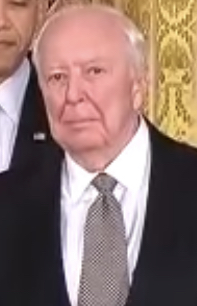
Jasper Johns is an American painter, sculptor, and printmaker whose work is associated with abstract expressionism, Neo-Dada, and pop art. He is well known for his depictions of the American flag and other US-related topics. Johns's works regularly sell for millions of dollars at sale and auction, including a reported $110 million sale in 2010. At multiple times works by Johns have held the title of most paid for a work by a living artist.
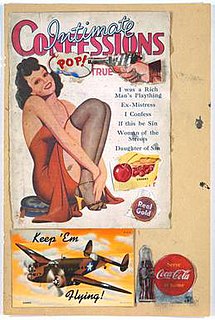
Pop art is an art movement that emerged in the United Kingdom and the United States during the mid- to late-1950s. The movement presented a challenge to traditions of fine art by including imagery from popular and mass culture, such as advertising, comic books and mundane mass-produced objects. One of its aims is to use images of popular culture in art, emphasizing the banal or kitschy elements of any culture, most often through the use of irony. It is also associated with the artists' use of mechanical means of reproduction or rendering techniques. In pop art, material is sometimes visually removed from its known context, isolated, or combined with unrelated material.

Milton Ernest "Robert" Rauschenberg was an American painter and graphic artist whose early works anticipated the Pop art movement. Rauschenberg is well known for his Combines (1954–1964), a group of artworks which incorporated everyday objects as art materials and which blurred the distinctions between painting and sculpture. Rauschenberg was both a painter and a sculptor, but he also worked with photography, printmaking, papermaking and performance.

Neo-Dada was a movement with audio, visual and literary manifestations that had similarities in method or intent with earlier Dada artwork. It sought to close the gap between art and daily life, and was a combination of playfulness, iconoclasm, and appropriation. In the United States the term was popularized by Barbara Rose in the 1960s and refers primarily, although not exclusively, to work created in that and the preceding decade. There was also an international dimension to the movement, particularly in Japan and in Europe, serving as the foundation of Fluxus, Pop Art and Nouveau réalisme.
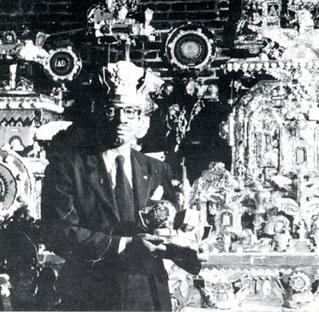
James Hampton was an American outsider artist. Hampton worked as a janitor and secretly built a large assemblage of religious art from scavenged materials, known as the Throne of the Third Heaven of the Nations' Millennium General Assembly. Often abbreviated to simply the Throne, it is currently on display at the Smithsonian American Art Museum in Washington. Art critic Robert Hughes of Time magazine wrote that the Throne "may well be the finest work of visionary religious art produced by an American."

Assemblage is an artistic form or medium usually created on a defined substrate that consists of three-dimensional elements projecting out of or from the substrate. It is similar to collage, a two-dimensional medium. It is part of the visual arts and it typically uses found objects, but is not limited to these materials.

Leo Castelli was an Italian-American art dealer who originated the contemporary art gallery system. His gallery showcased contemporary art for five decades. Among the movements which Castelli showed were Surrealism, Abstract Expressionism, Neo-Dada, Pop Art, Op Art, Color field painting, Hard-edge painting, Lyrical Abstraction, Minimal Art, Conceptual Art, and Neo-expressionism.

The Institute of Contemporary Art (ICA) is an art museum and exhibition space located in Boston, Massachusetts, United States of America. The museum was founded as the Boston Museum of Modern Art in 1936. Since then it has gone through multiple name changes as well as moving its galleries and support spaces over 13 times. Its current home was built in 2006 in the South Boston Seaport District and designed by architects Diller Scofidio + Renfro.
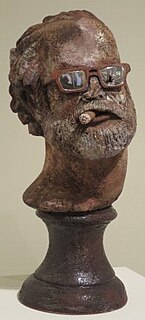
Robert Carston Arneson was an American sculptor and professor of ceramics in the Art department at University of California, Davis for nearly three decades.
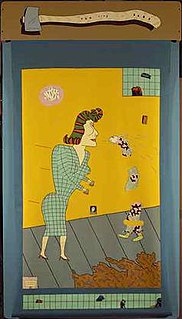
Funk art is an American art movement that was a reaction against the nonobjectivity of abstract expressionism. An anti-establishment movement, Funk art brought figuration back as subject matter in painting again rather than limiting itself to the non-figurative, abstract forms that abstract expressionists such as Jackson Pollock and Mark Rothko were depicting. The movement's name was derived from the jazz musical term "funky", describing the passionate, sensuous, and quirky. During the 1920s, jazz was thought of as very basic, unsophisticated music, and many people believed Funk was an unrefined style of art as well. The term funk also had negative connotations because the word had an association with a foul odor. Throughout the 1960s and 1970s, Funk was a popular art form, mainly in California's Bay Area in the United States. Although discussed as a cohesive movement, Funk artists did not feel as if they belonged to a collective art style or group. This is because while its artists shared the same attitudes and created similar works, they were not necessarily working together.
A combine painting or Combine is an artwork that incorporates elements of both painting and sculpture. Items attached to paintings might include three-dimensional everyday objects such as clothing or furniture, as well as printed matter including photographs or newspaper clippings.

Jessica Stockholder is a Canadian-American artist known for site-specific installation works and sculptures that are often described as "paintings in space." She came to prominence in the early 1990s with monumental works that challenged boundaries between artwork and display environment as well as between pictorial and physical experience. Her art often presents a "barrage" of bold colors, textures and everyday objects, incorporating floors, walls and ceilings and sometimes spilling out of exhibition sites. Critics suggest that her work is informed by diverse artistic traditions, including abstract expressionism, color field painting, minimalism and Pop art. Since her early career, they have noted in her work an openness to spontaneity, accident and marginality and a rejection of permanency, monetization and disciplinary conventions that Stephen Westfall characterized as an "almost shocking sense of freedom."
David Bradshaw is an American artist based in Cecilia, Louisiana, and East Charleston, Vermont. He is a painter, sculptor, and printmaker.

Moon Museum is a small ceramic wafer three-quarters by one-half inch in size, containing artworks by six prominent artists from the late 1960s. The artists with works in the "museum" are Robert Rauschenberg, David Novros, John Chamberlain, Claes Oldenburg, Forrest Myers and Andy Warhol.

Monogram is a Combine by American artist Robert Rauschenberg, made from 1955-1959. It consists of a stuffed Angora goat with its midsection passing through an automobile tire. Critic Jorg von Uthmann described it as Rauschenberg's most famous work in the Huffington Post. In 1965, Pontus Hultén purchased the artwork for the collection of the Moderna Museet in Stockholm.
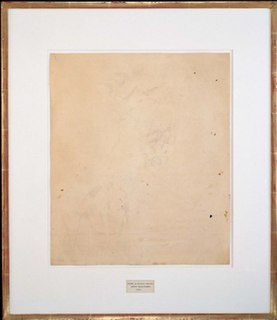
Erased de Kooning Drawing (1953) is an early work of American artist Robert Rauschenberg. This conceptual work presents an almost blank piece of paper in a gilded frame. It was created in 1953 when Rauschenberg erased a drawing he obtained from the Abstract Expressionist and American artist Willem de Kooning. Rauschenberg's friend and fellow artist, Jasper Johns, later framed it in a gilded frame and added a written caption to mimic the framing style of the Royal Academy and monogramming found on Renaissance drawings and prints. The caption reads: "Erased de Kooning Drawing, Robert Rauschenberg, 1953.” It has been in the collection of the San Francisco Museum of Modern Art (SFMOMA) since 1998. SFMOMA describes the work as a "drawing [with] traces of drawing media on paper with a label and gilded frame."

Donald Jay Saff is an artist, art historian, educator, and lecturer, specializing in the fields of contemporary art in addition to American and English horology.

Canyon is a 1959 artwork by American artist Robert Rauschenberg. The piece is one of his most celebrated and best known works, and is one of his Combines. Rauschenberg coined the phrase Combine in 1954 to describe his artworks that incorporate elements of both sculpture and painting. Canyon includes a taxidermied golden eagle and a pillow, along with other sculptural elements mounted on a painted and collaged canvas.

Adam Kuby is an American sculptor, visual artist and landscape designer, focusing on large-scale public art commissions and environmental art installations.
David Ross Novros, is an American artist. He is known for his minimalist geometric paintings, shaped canvases, and his use of color. He has also studied fresco painting extensively.

















